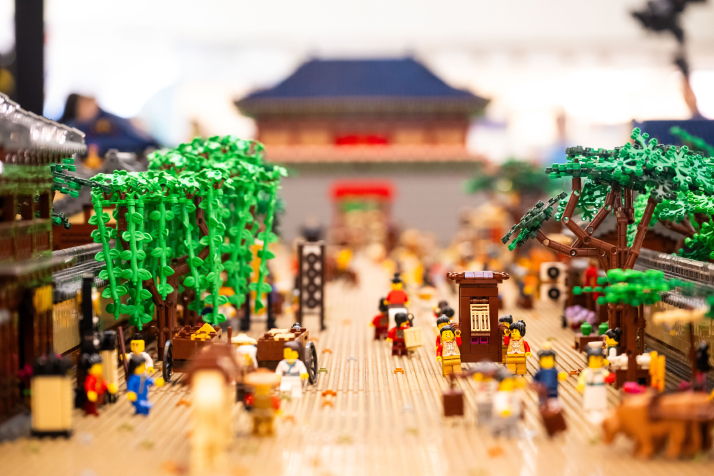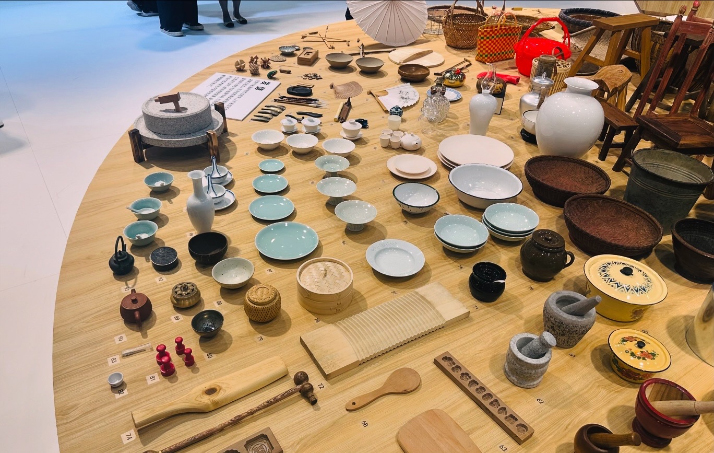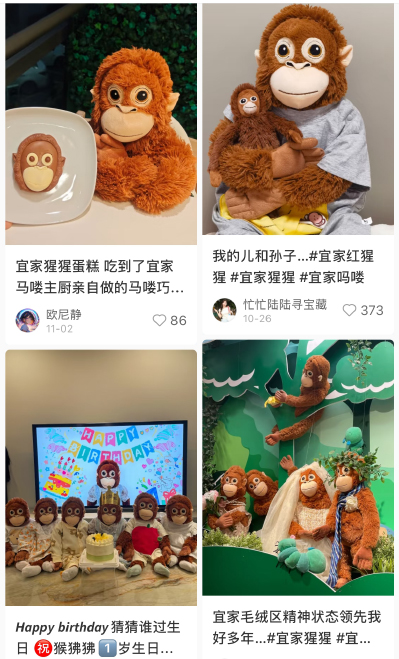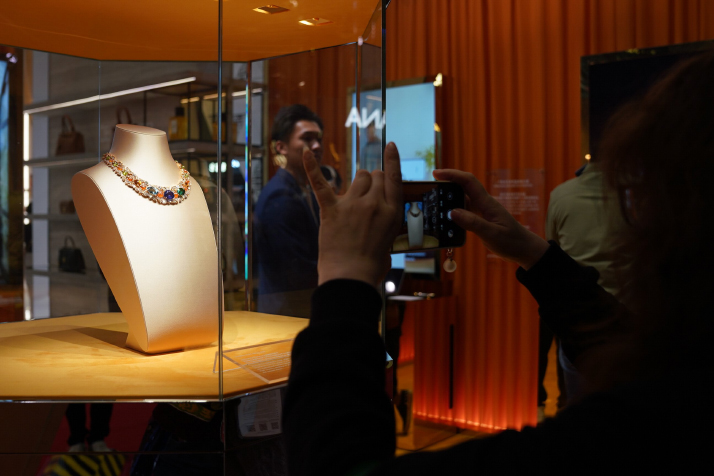| Business |
| Chasing the Chinese Element | |
|
|
 On display in Sha Tin, Hong Kong Special Administrative Region, the world's largest LEGO diorama is a rendition of the Chinese painting Along the River During the Qingming Festival (XINHUA)
For people with a poor sense of direction, navigating the China International Import Expo (CIIE), the world's first national-level expo dedicated to imports, can be a daunting challenge. At the seventh edition of the event, held in Shanghai between November 5 and 10, the pavilions of some 3,500 exhibitors from 129 countries and regions were spread across a multi-story complex spanning 420,000 square meters (equivalent to the size of 52 standard soccer fields). There was, however, a universal theme running through all exhibitions at this year's CIIE: the integration of Chinese elements into their products and exhibition space designs. In celebration of the Year of the Dragon in the Chinese calendar, a colossal golden dragon guarded the entrance to the pavilion of the LVMH Group, a French luxury conglomerate. A mini octagonal Chinese pavilion with decorated windows and revolving lanterns, completely made from LEGO bricks, was displayed at the booth of the Denmark-headquartered LEGO Group, the largest toy manufacturer in the world. The showroom of Swedish furniture giant IKEA was constructed around the concept of The Peach Blossom Spring, an ancient Chinese fable about an idyllic world. At the pavilion of MUJI, a Japanese household and consumer goods retailer, wooden structures from its stores across China were reconfigured into new installations that were inspired by traditional Chinese culture. These spaces are examples of how multinationals are adapting to China's changing consumer landscape with distinct localization strategies. Marks of time Perhaps the most emotion-packed display at this year's CIIE was an assortment of old objects that were once common in China but are now on the verge of disappearing. From traditional steelyard scales and oil-paper umbrellas to enamel mugs from the 1980s and tin kettles from the 1950s, an installation at the MUJI pavilion featured more than 200 vintage wares collected from the company's employees across China. Grouped into two major categories, fermentation and weaving, these items were arranged in concentric circles to mimic the growth rings of an ancient tree. This piece was curated by Found MUJI, a project that MUJI initiated in 2003 that travels around the world in search of old, almost forgotten objects that strongly reflect the cultures and customs of their region. These objects, which were "found" rather than "created," will then be converted by MUJI into modern items to be reproduced at reasonable prices. "Finding these items through MUJI brings me a deep sense of joy, which comes from a continuous discovery of the beauty of everyday life," Naoto Fukasawa, a Japanese designer and a member of MUJI's advisory board, said at the expo. "And Chinese daily items are always imbued with this type of quiet beauty." This project has coincided with the recent takeoff of the vintage trend in China, where more and more people are frequenting flea markets, antique stores and online secondhand platforms to collect used items. Nostalgia, an increased awareness for sustainability and a desire for individuality and self-expression all play a part in driving this trend. Kenya Hara, MUJI's art director, also partook in the trend by visiting several secondhand markets in Beijing to look for Chinese antiques for Found MUJI. The items that the project has found in China have also served as a constant source of inspiration for new MUJI products. Next year, the brand will launch an air fiber pillow that uses traditional Chinese weaving techniques and a toner inspired by fermented Chinese rice bran. These products are the latest results of the company's decades-long efforts in bringing itself ever closer to Chinese consumers. Since its official entry into the Chinese market in 2005, MUJI has established a complete industrial chain in the country, including design, raw material supplies, production and retail. Over the course of two decades, China has risen to become the retail giant's largest market outside Japan, with 401 stores spreading across 61 cities. "As of now, about 70 percent of MUJI's products sold in China have been produced entirely in the country. This is a great milestone in our localization strategy," Shimizu Zhi, General Manager of MUJI China, said at the expo. "At the same time, we are committed to further promoting Chinese designs to the wider world."  A collection of used items on display in Japanese household and consumer goods retailer MUJI's showroom at the seventh China International Import Expo (CIIE) in Shanghai on November 6 (PENG JIAWEI)
The ultimate goal, he said, is for at least half of all MUJI products sold in China to be locally designed. Brick by brick At some point in their youth, almost every Chinese millennial and Gen Z has dreamed of possessing a LEGO® Harry Potter™ set or a LEGO® Disney Castle. The Danish toy giant has captivated generations of Chinese consumers with its boundless ability to merge with global pop culture phenomena. For the 92-year-old brand, however, China is still a very young market. In 1993, the LEGO Group opened its first store on the Chinese mainland at Beijing Lufthansa Center, the very first Western-style department store in the city. "In some other countries, our toy sets are passed down through generations—something that one inherits from one's grandparents, whereas in China, the LEGO Group is a relative newcomer to the scene," Jenny Xu, Vice President of LEGO China Offline Branded Retail at the LEGO Group, who oversees the company's offline retail business, told Beijing Review. Fast forward 31 years, the company's presence in the country now spans a vast network of 480 stores across more than 120 cities. In recent years, these stores China have been increasingly re-imagined as spaces where local cultures blend seamlessly into the brand's universal themes. "Each of our stores in China was designed to reflect the cultural legacies of its locale," Xu said. A must-see landmark in Beijing's Wangfujing commercial district is the towering façade of an ancient Chinese palace, all constructed from LEGO bricks. In Changsha, Hunan Province, a gigantic LEGO mural has been created to recreate the city's blazing night views. In Fuzhou, Fujian Province, a LEGO minifigure wearing a traditional floral headpiece, a time-honored habit of local women, can be found in a beacon store of the brand. Such retail outlets offer a more individualized and immersive LEGO play experience via localized design. The company has also launched the Monkie Kid™ series, a product line inspired by the classic Chinese epic Journey to the West, as well as a Chinese New Year-themed seasonal set, which were both showcased at this year's CIIE. The centerpiece of this year's booth was an almost 5-meter-tall installation featuring a towering rainbow cascading into a fantastical LEGO landscape. The structure was both the work of some experienced LEGO certified professionals and model designers of the LEGO Group Jiaxing Factory and a compilation of individual projects crafted by tens of thousands of Chinese children. These projects belong to a program called Super-Playful Caravans. Departing from Shanghai on August 16, three pop-up caravan stores have embarked on a national tour through 18 Chinese cities, inviting children nationwide to design their own LEGO models. "For many Chinese parents, play and learning are opposite forces," Stella Shen, Marketing Vice President of LEGO China at the LEGO Group, told Beijing Review, noting that play is also an effective way to improve the physical, social, cognitive, emotional and creative capacities of children. According to this year's LEGO Play Well Report, an annual survey that traces the evolution of play worldwide, Chinese children still do not have enough time for play. In China, 85 percent of parents believe that their children's access to time and space for play are increasingly limited. "The power of learning through play has been one of our core philosophies," Paul Huang, Senior Vice President of the LEGO Group and General Manager of LEGO China, told Beijing Review. "We hope to make more Chinese families aware of the key role of play in child development, so that play can be better integrated into the life of Chinese children."  A screenshot of posts on Xiaohongshu, a leading lifestyle platform in China, related to IKEA's plush chimpanzee toys
A home away from home There is no other store in China quite like IKEA, which has evolved from a home decorating depot aimed at promoting a Scandinavian way of living to a family-friendly theme park, where customers are welcome to spend hours taking every product for a spin. In every IKEA store in the country, customers can be seen taking naps on display beds, zoning out in the sofa section and playing with stuffed animals on the children's floor. This May, the store's cafeteria, which sells ice cream for 1 yuan ($0.13) and Swedish meatballs for 20 yuan ($2.76), went viral on Chinese social media, where it earned the nickname Canteen for the Budget-Tight. "A shift that we have noticed since we entered China in 1998 is that Chinese consumers are becoming more rational and price-conscious," Ruan Linjuan, Vice President of IKEA China, told Beijing Review, adding that the company has recently announced plans to cut the prices of more than 300 of its products sold in China. Ruan also highlighted the recent rise of a trend called "emotional spending," where consumers are trading the material for the spiritual. "There is a change of focus from the functionality of an item toward its emotional appeals," Ruan said. "The younger generations hope that their purchases are one of a kind, that their homes reflect their personalities and life choices." Products have also been redesigned with Chinese customers in mind, Ruan said. Examples include deepened bowls designed to hold rice and raised-legged sofas that allow robot vacuum cleaners, a popular item in Chinese households, to move underneath. A central concept for IKEA's showroom at the seventh CIIE was evolving with China's silver economy. Statistics released by the World Health Organization show that China has one of the world's fastest aging populations, with seniors aged 60 and above projected to account for 28 percent of the entire population by 2040. "All along we have been pondering how we can better cope with this demographic shift," Ruan said, noting that IKEA has added handrails to their bathroom designs and are also making their tables and cabinets taller to provide greater support in case seniors need something to hold onto. New trends are forever on the rise as the society evolves, which requires us to continuously search for innovative ideas to better meet the needs of Chinese consumers, Ruan said. Still bejeweled While IKEA has prioritized making itself more affordable to Chinese customers, BVLGARI, an Italian fashion house known for its jewelry and watches, is betting big on China's luxury spending power. "China is our number one market worldwide. And we are very proud, because we arrived only in 2004," Jean-Christophe Babin, the brand's CEO, told Beijing Review. In that year, BVLGARI, owned by LVMH, opened its first store on the Chinese mainland, a 12-square-meter boutique, in the Peninsula Beijing, China's first luxury hotel. Two decades later, the company now has some 100 stores covering a collective 40,000 square meters and employs 1,500 people on the mainland.  A BVLGARI necklace on display at the sixth CIIE in Shanghai on November 10, 2023 (XINHUA)
And BVLGARI is confident that these numbers will continue to grow. In 2023, China's luxury market, rebounding from the previous year's decline, saw a 12-percent year-on-year increase, consulting firm Bain & Co. reported. The same report predicted that China will account for 35 to 40 percent of the global luxury market by 2030. For Babin, this growth has been largely driven by the rise of China's shecomony. In this type of economy, Chinese women, empowered by improved social status and rising purchasing power, have assumed a greater role in luxury consumption. "A notable trend is that Chinese women are buying jewelry for themselves, whereas in the past, they were mostly given it by their husbands or boyfriends," Babin said, adding that luxury has become a celebration of personal growth, not just a celebration of love. Babin also noted that the entry of luxury brands into e-commerce is another prominent shift in China's retail landscape, one on which BVLGARI wishes to further capitalize. "We plan to further expand our network into smaller Chinese cities, as what is a small city in China has the purchasing power of a big metropolis in Europe," he said. "And we are going to reach these markets, where there are currently no brick-and-mortar stores, through Tmall, JD.com and other e-commerce platforms." China will continue to be a major driving force of the global economy, and we believe that we are endowed with the opportunity to take the brand to a much higher level by riding the tide of the country's development, he concluded. Copyedited by G.P. Wilson Comments to pengjiawei@cicgamericas.com |
|
||||||||||||||||||||||||||||
|